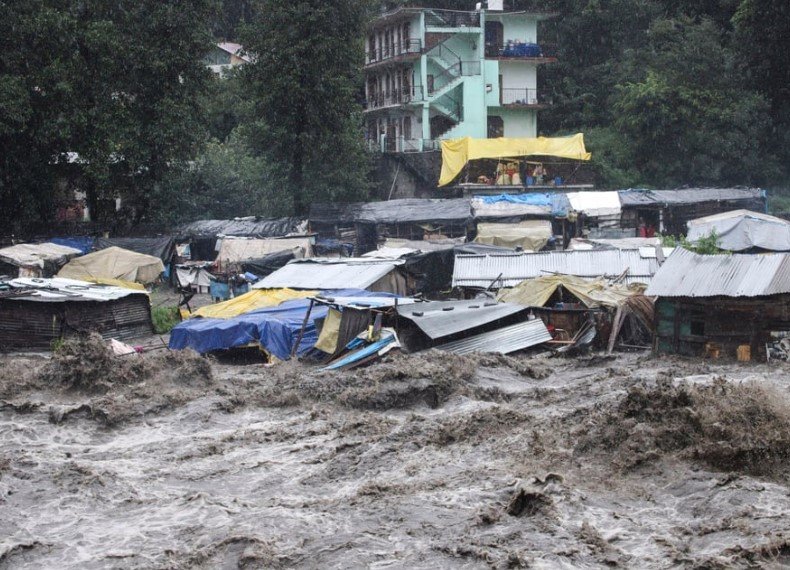At least three fatalities reported in Ramban district as torrential rain wreaks havoc across the region
Jammu and Kashmir has been reeling from torrential rainstorms that have left a path of destruction, particularly in the Ramban district. In the last two days, the heavy downpours have caused flash floods, landslides, and widespread damage, claiming the lives of at least five individuals. The Jammu-Srinagar highway, a vital artery connecting the region, has been blocked, creating chaos and disruption for travelers and locals alike. The situation remains dire, with authorities working round the clock to manage the fallout of the severe weather.
Flash Floods and Landslides: Ramban Hit Hardest
On Sunday, April 20, 2025, Ramban district bore the brunt of the catastrophic weather events. Landslides triggered by the relentless rainfall swept away homes in the Bagna village area, leading to the tragic deaths of three people. Approximately 30 homes were destroyed, leaving families devastated and without shelter.
In addition to the lives lost, the landslides caused significant damage to infrastructure. Vehicles were caught in the debris, rendering rescue efforts even more challenging. The Jammu-Srinagar highway, a crucial route for the region, was blocked from both ends, disrupting transportation and supply lines. The blocked highway also hampered the efforts to get relief supplies to affected areas, adding to the growing distress in the region.
Heavy rainfall is being blamed for the ongoing landslides, which are further complicating the situation in a region already prone to such natural disasters. Locals are struggling to come to terms with the scale of the damage, with many unsure of how to rebuild or where to go for safety.

A Region Already Vulnerable to Natural Disasters
Jammu and Kashmir, nestled in the Western Himalayas, is no stranger to adverse weather events. The region frequently experiences flash floods and landslides during the monsoon season, but this recent bout of torrential rain appears to have been particularly severe. The India Meteorological Department (IMD) had issued warnings earlier in the week, predicting heavy to very heavy rainfall over the region. However, the intensity and rapid onset of the rain caught many off guard, exacerbating the damage.
This event underscores the vulnerability of the region to climate-driven extremes. In addition to the immediate damage caused by the floods and landslides, the long-term effects on the local economy, infrastructure, and agriculture are expected to be profound. Farmers, who rely heavily on the agricultural sector, have already reported losses, and rebuilding efforts will require significant resources.
Immediate Impact: Casualties and Disruptions
The human toll of this disaster is being keenly felt across Jammu and Kashmir. In Ramban alone, three lives were claimed by the landslides, but the overall toll has reached five in the Jammu region over the last 48 hours. Relief teams have been dispatched to the worst-hit areas, but the challenging terrain and weather conditions are slowing down the rescue operations.
The loss of homes and property has forced many families to seek refuge in temporary shelters. As of now, the most pressing concern is the continued rainfall, which threatens to worsen the situation. The National Disaster Response Force (NDRF) and local authorities are coordinating efforts to evacuate residents from high-risk areas, but with the Jammu-Srinagar highway blocked, the logistics of getting people to safety remain complicated.
The IMD has predicted that the heavy rain might continue for a few more days, heightening fears of further flash floods and landslides. In response, schools in the region have been closed for the day, and authorities have urged the public to stay indoors and avoid venturing into vulnerable areas.
Weather Warnings and the Road Ahead
As the rain continues to pour, there is a sense of urgency in the air. The IMD had alerted the region about the likelihood of heavy rainfall earlier in the week, but the speed at which the weather turned extreme took many by surprise. Authorities are now focused on managing the immediate fallout while also preparing for any additional severe weather events.
Residents are being urged to stay updated on the weather and heed the warnings issued by local authorities. The Jammu and Kashmir administration is working with national disaster management teams to ensure swift relief operations and to prevent further loss of life.
While the immediate threat of flash floods may subside in the coming days, the recovery process will be long and difficult. The region will need substantial support in terms of relief aid, resources for rebuilding homes, and long-term measures to mitigate the risk of future disasters.
